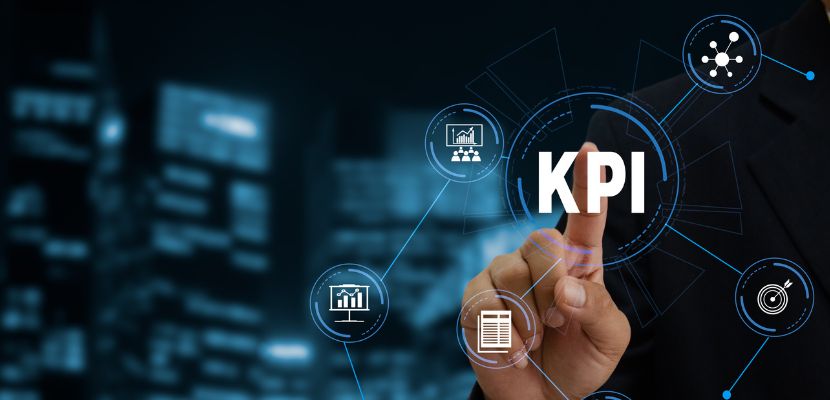Leading and lagging KPIs are key performance indicators used to measure progress and success in different ways. Leading KPIs are predictive metrics that indicate future performance and guide proactive decision making, while lagging KPIs measure past outcomes to assess overall success or failure.

What Are Leading KPIs?
Leading KPIs are forward-looking metrics that help predict future performance by measuring the inputs or activities that influence outcomes. These indicators provide early signals of whether a team or organization is on track to meet its goals.
For example, in sales, the number of leads generated is a leading KPI that can indicate future revenue potential. By focusing on actionable and controllable factors, leading KPIs enable organizations to make timely adjustments, improve processes, and increase the likelihood of achieving desired results.
Leading KPIs Examples
Here are a few examples of leading KPIs across different areas:
Sales and Marketing
- Number of new leads generated.
- Website traffic volume.
- Email open and click-through rates.
Customer Support
- Average response time to customer inquiries.
- Customer satisfaction scores (immediate post-interaction surveys).
- Number of support tickets resolved within a specific time frame.
Human Resources
- Number of job applications received.
- Employee training hours completed.
- Employee engagement survey participation rate.
Operations
- Production downtime hours.
- Inventory turnover rate.
- Number of preventive maintenance activities conducted.
Finance
- Percentage of invoices sent on time.
- Cash flow forecast accuracy.
- Number of cost-reduction initiatives implemented.
How Are Leading KPIs Used?
Leading indicators are used to anticipate and influence future outcomes by monitoring activities or inputs that drive performance. Organizations use them to identify trends, evaluate progress, and make proactive adjustments to improve results. For instance, tracking customer inquiries helps to predict future sales, while monitoring training hours can forecast improvements in employee productivity.
Leading indicators are typically actionable, meaning they provide specific areas where immediate action can be taken to improve performance. By focusing on these early signals, organizations can address potential challenges, seize opportunities, and align efforts with strategic goals before final outcomes are realized.
What Are Lagging KPIs?
Lagging KPIs are metrics that measure the outcomes or results of past actions, providing insights into overall performance and achievement of goals. These indicators are typically retrospective, focusing on what has already occurred, such as revenue growth, customer retention rates, or profit margins.
While they are useful for evaluating success and identifying trends, lagging KPIs cannot influence future results directly, as they are based on historical data. Organizations use them to assess whether strategies and objectives have been met and to guide future planning and adjustments.
Lagging KPIs Examples

Here are a few examples of lagging KPIs:
- Revenue growth. Measures the increase in revenue over a specific period, reflecting past sales performance.
- Customer retention rate. Indicates the percentage of customers retained during a set timeframe, showing the success of customer satisfaction and loyalty strategies.
- Net profit margin. Tracks the percentage of profit earned after expenses, providing insight into overall financial health.
- Project completion rate. Measures the number of completed projects against the total, reflecting efficiency and execution success.
- Employee turnover rate. Assesses the rate at which employees leave the organization, highlighting past workforce stability or challenges.
- Average order value (AOV). Calculates the average revenue per transaction, showing historical purchasing behavior trends.
How Are Lagging KPIs Used?
Lagging KPIs are used to evaluate past performance and measure the outcomes of strategies, projects, or initiatives. They provide insights into the effectiveness of efforts by analyzing results such as revenue growth, customer retention, or profit margins. Organizations rely on these metrics to identify trends, assess whether goals were met, and make informed decisions for future planning. While they don’t predict future outcomes, lagging KPIs offer a clear picture of what has been achieved and highlight areas where adjustments may be needed to improve performance moving forward.
Leading KPIs vs. Lagging KPIs
Here’s a comparison table for Leading KPIs vs. Lagging KPIs:
| Aspect | Leading KPIs | Lagging KPIs |
| Focus | Predicts future outcomes. | Measures past results. |
| Timing | Forward-looking; evaluated during processes. | Backward-looking; assessed after outcomes. |
| Purpose | Provides early warning signals to guide adjustments. | Evaluates the effectiveness of strategies and goals. |
| Examples | Number of leads, website traffic, training hours, etc. | Revenue growth, customer retention, net profit, etc. |
| Actionability | Proactive; influences change. | Reactive; identifies areas for improvement. |
| Timeframe | Immediate, short-term focus. | Long-term, outcome-based focus. |
| Measurement type | Tracks inputs, activities, or behaviors. | Tracks outputs or results. |
| Dependency | Independent of outcomes; drives performance. | Dependent on preceding activities or decisions. |
How to Choose Leading and Lagging Indicators?
Choosing leading and lagging indicators involves aligning them with your organization’s goals and ensuring they provide actionable insights. Here’s how to select them effectively:
- Understand your goals. Define clear objectives. Leading indicators should track the activities driving progress toward these goals, while lagging indicators should measure the outcomes.
- Identify key drivers. Determine the inputs or activities that influence your desired results. These will form the basis of your leading indicators.
- Assess relevance and feasibility. Ensure indicators are relevant to your industry, easily measurable, and tied directly to performance. Avoid metrics that are hard to track or don’t impact decision-making.
- Balance leading and lagging metrics. Use a mix of both types to monitor processes and outcomes. Leading indicators help make proactive adjustments, while lagging indicators validate long-term success.
- Focus on actionability. Choose indicators that prompt specific actions. Leading indicators should guide real-time changes, while lagging indicators should drive strategic improvements.
- Test and refine. Monitor the indicators over time to ensure they are delivering meaningful insights. Adjust metrics as needed to maintain their relevance and impact.
How to Measure Leading and Lagging Indicators?
Measuring leading and lagging indicators requires a structured approach tailored to their unique characteristics:
Measuring Leading Indicators
- Identify key drivers. Determine activities or inputs that directly influence desired outcomes (e.g., sales calls, website traffic, or employee training hours).
- Set metrics. Define measurable and actionable metrics, such as the number of leads generated or customer inquiries.
- Track in real time. Use tools like CRM systems, analytics platforms, or employee monitoring software to capture data as activities occur.
- Establish benchmarks. Set realistic targets based on historical data or industry standards.
- Analyze trends. Regularly review data to spot patterns and adjust strategies to improve future outcomes.
Measuring Lagging Indicators
- Define desired outcomes. Identify specific results to measure, such as revenue growth, customer retention, or project completion rates.
- Collect historical data. Use tools like accounting software, customer databases, or performance dashboards to gather past performance metrics.
- Set timeframes. Measure results over specific periods to evaluate the effectiveness of past actions.
- Compare against goals. Assess whether actual outcomes meet predefined goals or benchmarks.
- Review for insights. Analyze the data to identify trends, strengths, and areas for improvement.